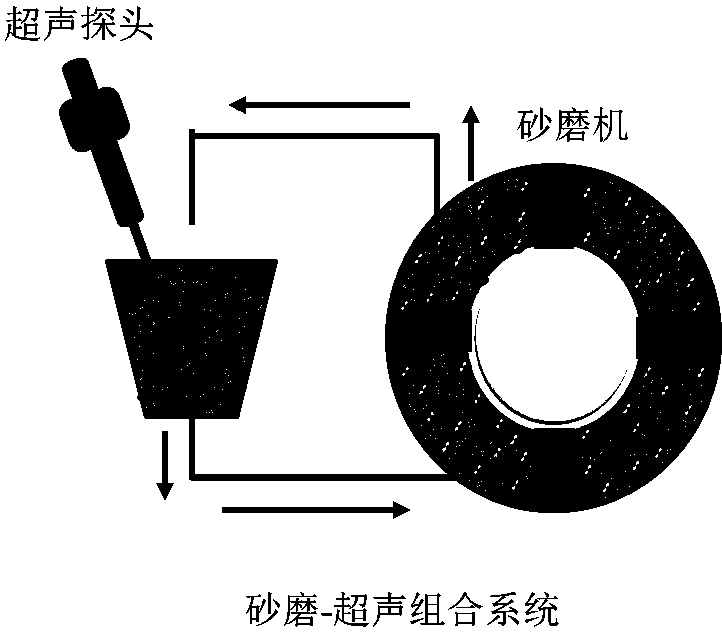Preparation method of biomass-graded porous carbon material
A technology of hierarchical porous and biomass raw materials, applied in the field of porous carbon materials, can solve the problems of limited sources, high cost, complex process, etc., and achieve the effects of enhanced compatibility, good performance and wide adaptability
- Summary
- Abstract
- Description
- Claims
- Application Information
AI Technical Summary
Problems solved by technology
Method used
Image
Examples
Embodiment 1
[0051] The steps for preparing biomass porous carbon nanomaterials in this embodiment:
[0052] 1) Pyrolysis: Pyrolysis and carbonization of 30 g of dried and crushed corn cob particles in a nitrogen protective atmosphere, grinding the carbonized material, and passing through a 50-mesh sieve to obtain a carbon-containing solid powder; The decarburization conditions were as follows: at a nitrogen flow rate of 150 mL / min, the temperature was raised from 25 °C to 500 °C at a rate of 5 °C / min, and kept at 500 °C for 1 h.
[0053] 2) Ultrafine treatment: Disperse 15g of carbon-containing solid powder in step 1) in 300mL of isopropanol aqueous solution (the volume ratio of isopropanol to deionized water is 3:7), and then ultrasonically and sand mill together Under the effect of superfine treatment, to obtain a suspension, the suspension is centrifuged at 10000 rpm, collected and dried to obtain an ultrafine carbon powder; in the present embodiment, the treatment time of the superfin...
Embodiment 2
[0062] The steps for preparing biomass porous carbon nanomaterials in this embodiment:
[0063] 1) Pyrolysis: Pyrolysis and carbonization of 30 g of dried and crushed corn cob particles in a nitrogen protective atmosphere, grinding the carbonized material, and passing through a 50-mesh sieve to obtain a carbon-containing solid powder; The decarburization conditions were as follows: at a nitrogen flow rate of 150 mL / min, the temperature was raised from 25 °C to 500 °C at a rate of 5 °C / min, and kept at 500 °C for 1 h.
[0064] 2) Ultrafine treatment: Disperse 15g of carbon-containing solid powder in step 1) in 300mL of isopropanol aqueous solution (the volume ratio of isopropanol to deionized water is 3:7), and then ultrasonically and sand mill together Under the effect of superfine treatment, to obtain a suspension, the suspension is centrifuged at 10000 rpm, collected and dried to obtain an ultrafine carbon powder; in the present embodiment, the treatment time of the superfin...
Embodiment 3
[0070] The steps for preparing biomass porous carbon nanomaterials in this embodiment:
[0071] 1) Pyrolysis: Pyrolysis and carbonization of 30 g of dry and crushed straw particles in a nitrogen protective atmosphere, grinding the carbonized material, and passing through a 50-mesh sieve to obtain a carbon-containing solid powder; the pyrolysis described in this example The carbonization conditions were as follows: at a nitrogen flow rate of 150 mL / min, the temperature was raised from 25 °C to 400 °C at a rate of 3 °C / min, and kept at 400 °C for 1 h.
[0072] 2) Ultrafine treatment: Disperse 15g of carbon-containing solid powder in step 1) in 300mL of water, then perform ultrafine treatment under the combined action of ultrasound and sand mill to obtain a suspension, and centrifuge the suspension at 10,000 rpm , to obtain ultrafine carbon powder after collection and drying; in this embodiment, the treatment time of ultrafine treatment is 10h; the power of the ultrasonic wave is...
PUM
| Property | Measurement | Unit |
|---|---|---|
| particle size | aaaaa | aaaaa |
| particle size | aaaaa | aaaaa |
| particle size | aaaaa | aaaaa |
Abstract
Description
Claims
Application Information
 Login to View More
Login to View More - R&D
- Intellectual Property
- Life Sciences
- Materials
- Tech Scout
- Unparalleled Data Quality
- Higher Quality Content
- 60% Fewer Hallucinations
Browse by: Latest US Patents, China's latest patents, Technical Efficacy Thesaurus, Application Domain, Technology Topic, Popular Technical Reports.
© 2025 PatSnap. All rights reserved.Legal|Privacy policy|Modern Slavery Act Transparency Statement|Sitemap|About US| Contact US: help@patsnap.com



